Introduction
Mobile commerce, or m-commerce, has emerged as a powerful force reshaping how consumers interact with products and services in an increasingly digital world. This dynamic sector encompasses a broad range of activities, from mobile shopping and banking to payments and marketing, reflecting the profound shift in consumer behavior towards mobile devices. As smartphones and tablets become integral to everyday life, businesses are compelled to adapt their strategies to meet the demands of a tech-savvy audience.
The rise of m-commerce is not merely a trend; it represents a vital component of the digital economy that is continuously evolving. With innovations in payment technologies, user experience enhancements, and a growing focus on security, the landscape of m-commerce is set for explosive growth, creating both challenges and opportunities for businesses aiming to thrive in this competitive marketplace.
Definition of m-commerce
'Commerce conducted via portable devices, often known as m-commerce, includes a dynamic environment where individuals participate in the purchasing and trading of products and services through gadgets like smartphones and tablets.'. This sector encompasses different activities such as shopping via smartphones, banking through devices, and payments using handheld gadgets, illustrating the increasing tendency of individuals preferring portable options for their transactions.
As technology evolves, so does the m-commerce environment, shaping consumer habits and preferences. For instance, the payments sector is projected to witness significant growth, driven by innovations such as sound wave-based payments and the increasing penetration of smartphones, particularly in emerging markets. The ease of use and financial inclusion offered by mobile technologies are critical factors propelling this expansion. However, the industry must also navigate challenges such as security concerns and high-profile data breaches that could affect public trust and adoption rates.
A notable shift in buyer behavior was accelerated by the COVID-19 pandemic, which heightened the demand for contactless payment solutions. According to industry insights, key segments of mobile payments include NFC (Near Field Communication), QR-based systems, and text-based transactions, spanning regions like North America, Europe, and Asia Pacific. The m-commerce market is notably fragmented, with leading players such as Google, Mastercard, and PayPal vying for dominance.
Moreover, businesses are adapting to changing consumer expectations. For example, brands are increasingly integrating advanced technologies to improve user satisfaction and streamline transactions, ensuring that they meet the demands of a digitally savvy audience. This integration of technology not only simplifies the shopping experience but also fosters long-lasting customer relationships, which are vital in today's competitive market.
In conclusion, m-commerce is not merely a trend but a vital component of the digital economy that continues to evolve. As companies invest in portable technologies and adjust to customer demands, they set themselves up for achievement in a swiftly evolving market.
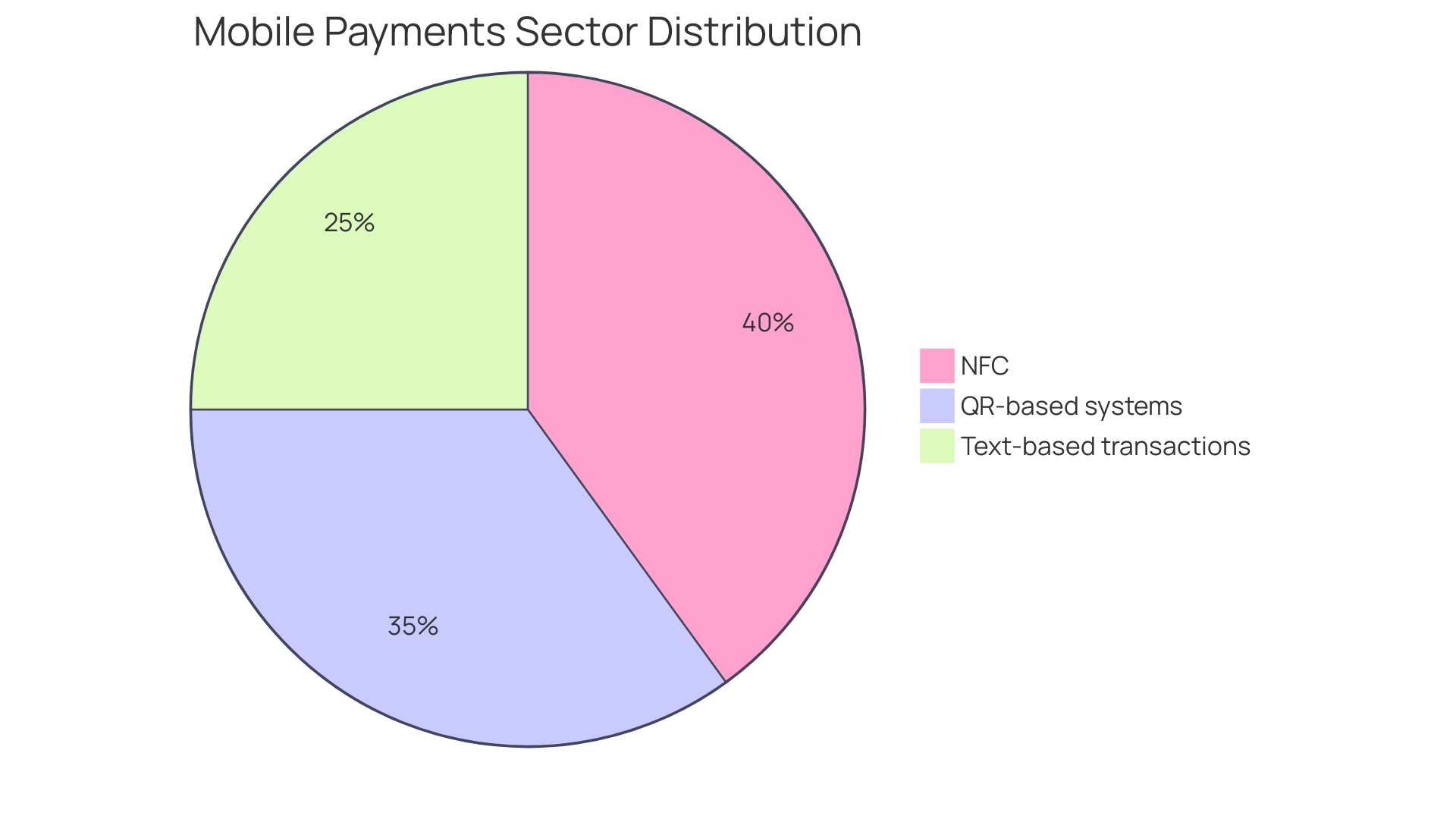
Types of m-commerce
'M-commerce, or commerce conducted via handheld devices, encompasses a variety of categories, each tailored to meet the diverse requirements of users and industries.'. Here’s a deeper look into the main types:
-
Mobile Shopping: This segment has witnessed significant evolution, especially with the rise of mobile applications and websites designed to provide seamless shopping experiences. In 2023, it was reported that app usage surged, with consumers spending an average of over five hours daily on handheld devices, underscoring the importance of optimizing shopping platforms.
-
Mobile Banking: The landscape of banking has transformed dramatically with the emergence of nearly 300 neo banks, which have set new standards for user experience. Traditional banks are now investing heavily in digital transformation to compete effectively. For instance, as customers seek more innovative and user-friendly banking solutions, many are finding it essential to narrow the service gap with neobanks.
-
Mobile Payments: This type of m-commerce is rapidly growing, driven by technological advancements like NFC and QR-based payments. In 2022, remote payments alone captured approximately 60% market share, reflecting a shift towards contactless payment methods amid rising security concerns. The payments market is anticipated to keep growing, particularly in developing economies where smartphone usage is rising.
-
Specialized Applications: Beyond general shopping and banking, numerous sectors are developing tailored applications. For example, sectors like gaming and financial services are utilizing technology to boost user interaction through gamified experiences and personalized interfaces. This trend aligns with the increasing demand from buyers for personalized services and the integration of generative AI to enhance these applications.
Overall, as portable technology advances, so too will the types and functionalities of m-commerce, making it a critical area for businesses to monitor and adapt.
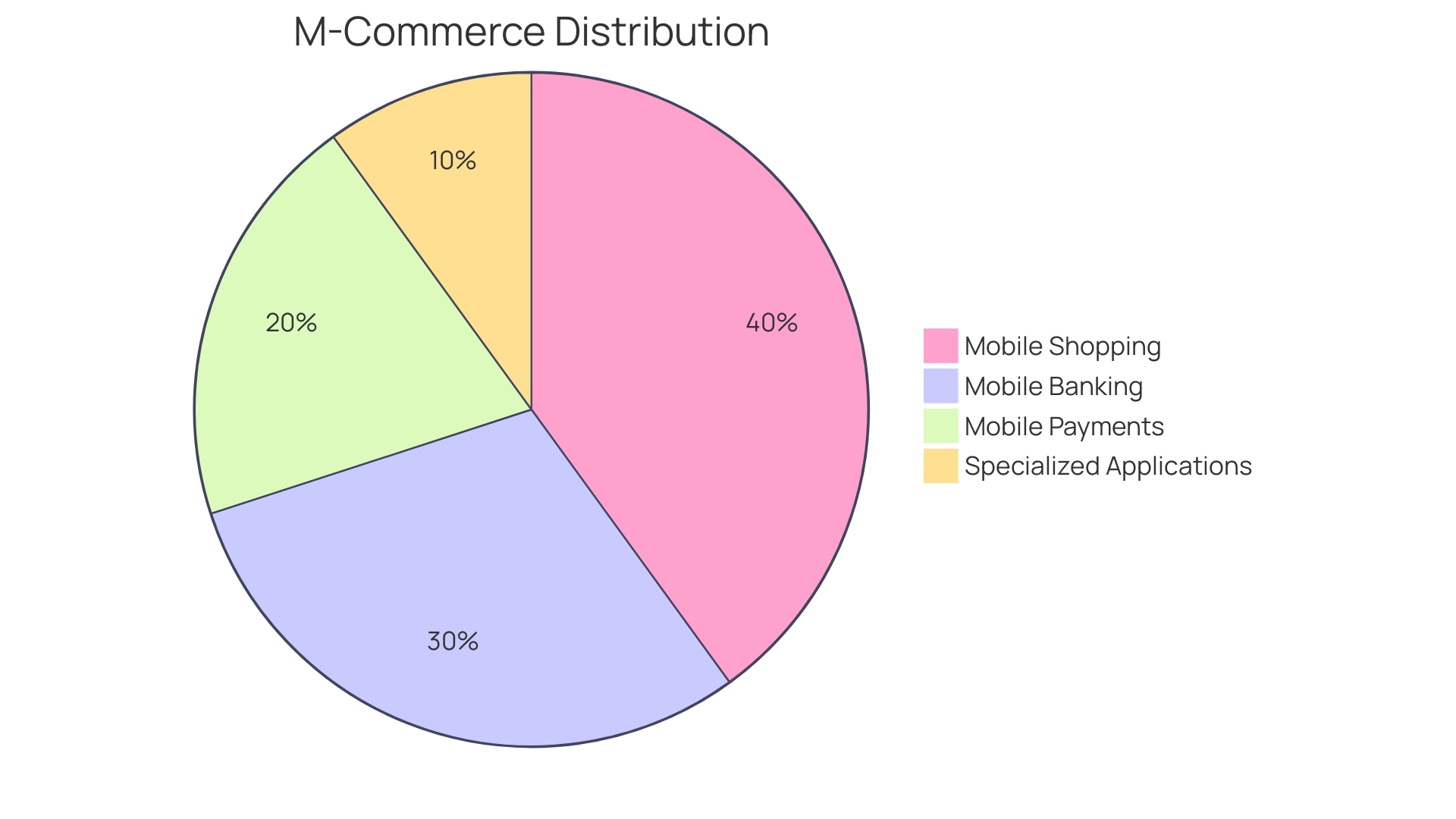
Mobile Shopping
Mobile commerce, or m-commerce, represents a significant evolution in the retail landscape, allowing consumers to shop directly from their smartphones and tablets. This smooth purchasing process can be enabled through specialized mobile applications or sites specifically created for mobile devices. Key features such as personalized product suggestions, intuitive navigation, and robust security measures during checkout play crucial roles in enhancing the overall user satisfaction.
Recent research indicates that 72% of fashion and sportswear shoppers do not categorize themselves as solely online or in-store customers; instead, they prefer a hybrid approach that combines both environments. This shift highlights the necessity for retailers to offer a consistent shopping journey across all channels. The tactile interaction available in physical stores remains important to 55% of shoppers, while 35% visit brick-and-mortar locations to compare options firsthand. Moreover, 69% of consumers find motivation from in-store interactions, further highlighting the necessity for an omnichannel approach that combines m-commerce and conventional retail.
Ripley, a leading retailer in Chile and Peru, recognized this trend and developed a user-centric mobile application to meet the needs of its customers. The app was designed with a clear vision for a seamless purchasing experience, enabling users to buy and browse easily and reliably from anywhere. The project commenced with a week of Lean Inception, where cross-functional teams collaborated to establish clear objectives and key results (OKRs) for the app's minimum viable product (MVP). This approach not only fostered knowledge sharing among the team but also ensured that user research informed every aspect of the application, leading to a product tailored to consumer expectations.
The growing dependence on handheld gadgets for purchases is supported by substantial data, with online retail sales in the U.S. anticipated to hit $1.26 trillion by the end of 2024 and $1.72 trillion by 2027. With over 30% of the worldwide population participating in internet purchasing, the m-commerce industry is set for significant expansion, making it essential for sellers to invest in technology that improves transactions via smartphones.
The integration of modern technologies, such as IoT and data analytics, is set to redefine the shopping landscape further. These innovations allow retailers to optimize operations and provide tailored experiences, establishing commerce via smartphones as a cornerstone of future retail success.
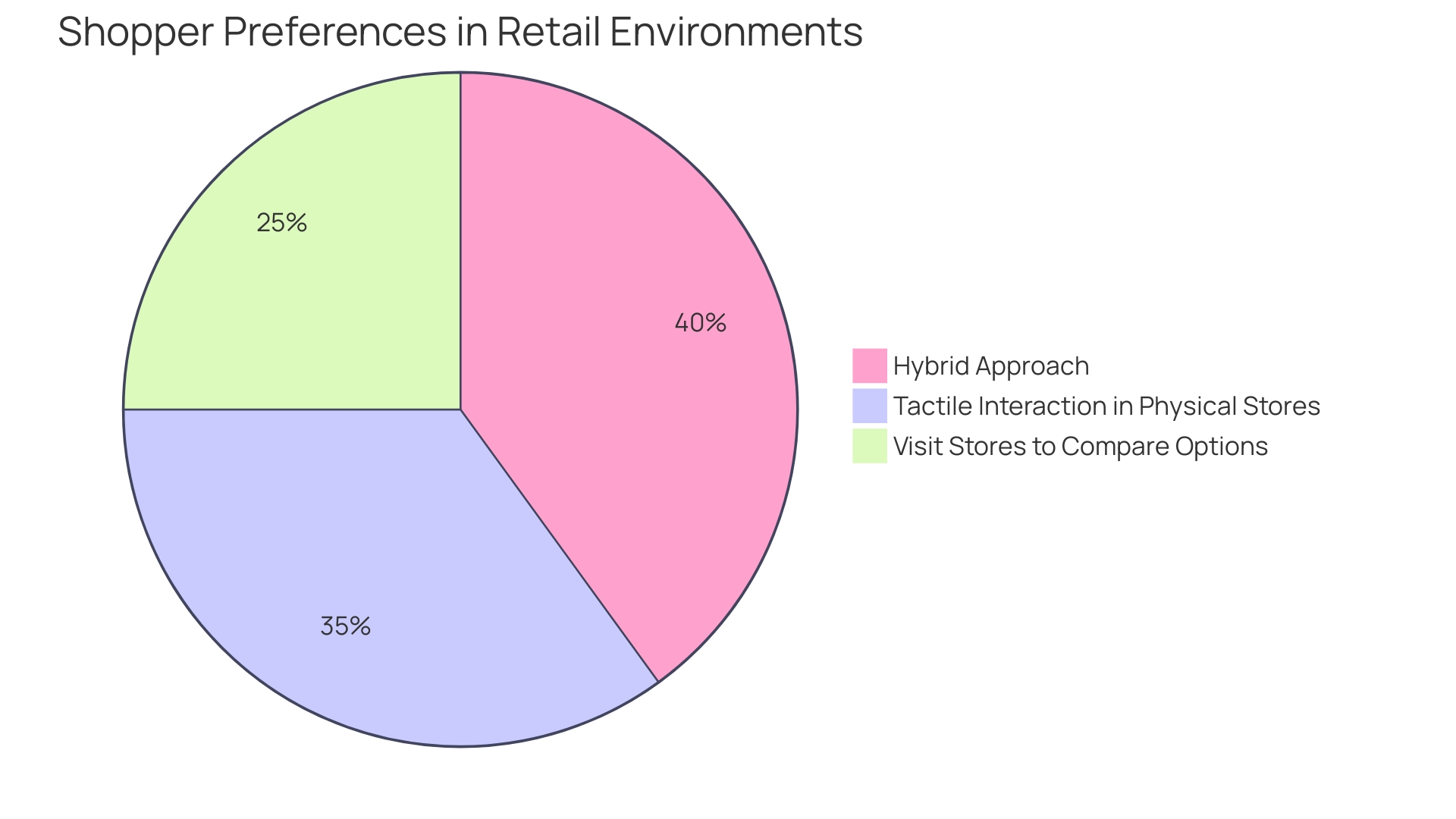
Mobile Banking
'Banking through handheld devices has changed the manner in which users interact with their finances, enabling them to perform a broad range of transactions directly from their gadgets.'. This capability encompasses checking account balances, transferring funds, paying bills, and accessing various financial services, all at the touch of a button.
Safety continues to be a critical issue in this digital environment, as the growth in banking via smartphones has also resulted in a rise in possible weaknesses. Biometric authentication is emerging as a critical component in enhancing security protocols. Industry leaders, such as MasterCard, are at the forefront of this shift, advocating for a future where cumbersome passwords are replaced by more secure and user-friendly biometric solutions. As MasterCard's vision illustrates, the aim is to eliminate the vulnerabilities associated with traditional authentication methods, thereby making banking via smartphones safer and more convenient for users.
The evolution of mobile banking is further emphasized by recent buyer behavior trends. A survey revealed that over 90% of individuals utilized some form of digital payment in the past year, a figure that has been steadily increasing, particularly in the wake of the COVID-19 pandemic. This surge in adoption reflects a growing trust in digital banking solutions, as individuals are increasingly open to exploring new technologies that enhance convenience and improve their overall user experience.
As organizations continue to innovate and integrate advanced security measures, the future of banking promises to be more secure and customized to meet the changing requirements of users.
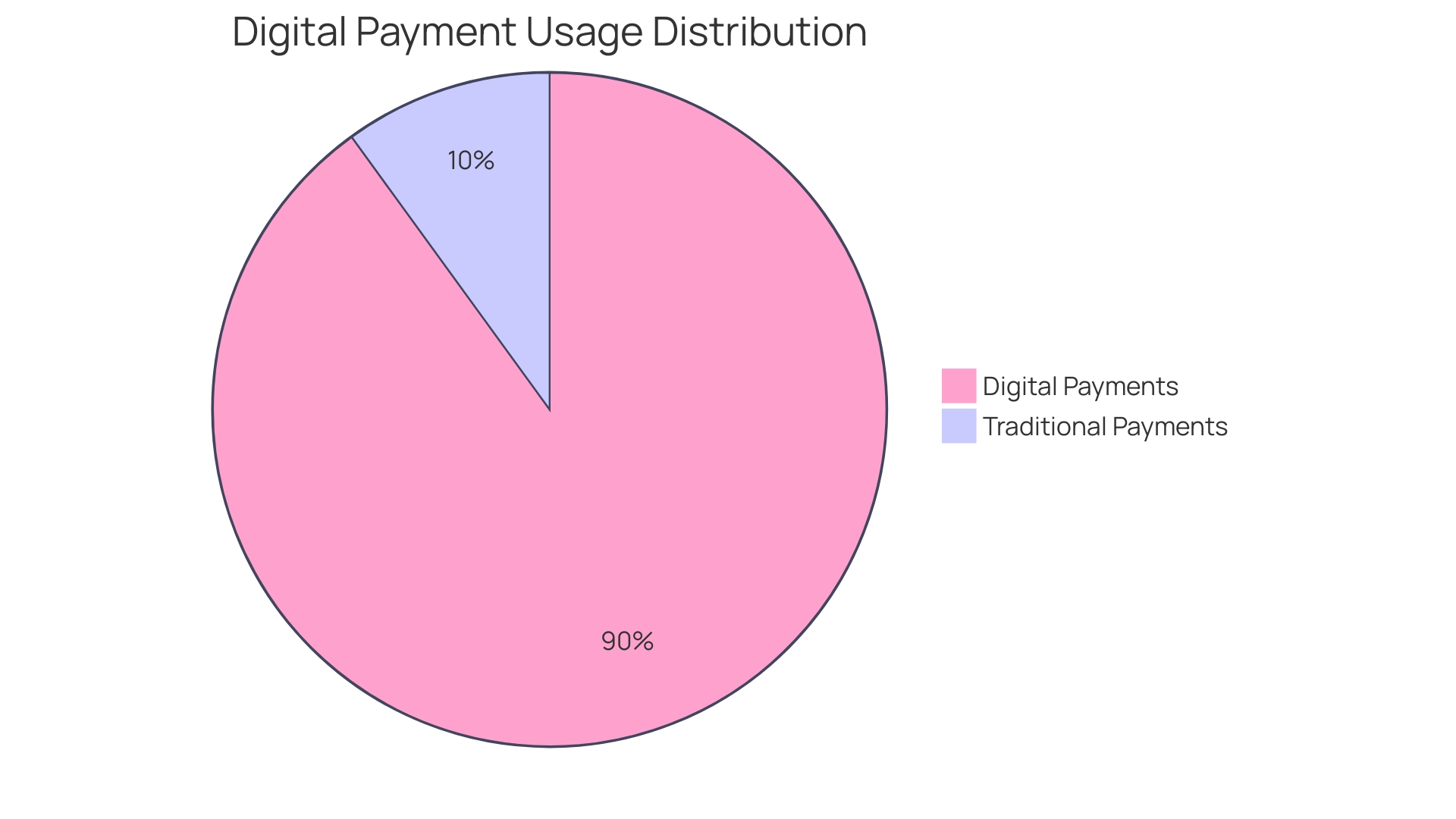
Mobile Payments
Wireless payments have transformed the manner in which individuals participate in financial exchanges, allowing them to conduct purchases with their portable devices instead of depending on conventional payment methods. This innovation encompasses a variety of solutions, including digital wallets and contactless payment systems. Digital wallets, for instance, are projected to be utilized by an estimated 5.2 billion people worldwide by 2026, highlighting their growing importance in the global economy.
'The convenience provided by portable payment methods significantly matches modern buyer expectations for speed and simplicity.'. Smart device payment methods can securely store information for multiple bank accounts, making transactions not only quick but also reliable. As Dr. Yvonni Markaki notes, these advancements in digital payments have transformed everyday financial transactions, allowing consumers to shop, pay bills, and transfer money with a simple tap or click.
Additionally, the increasing need for cross-border transactions further drives the acceptance of payment alternatives. As businesses and customers seek efficient and secure digital solutions for international commerce, cross-border payments are anticipated to exceed $100 trillion globally in the next decade. This shift highlights the necessity for retailers to incorporate payment systems into their platforms, ensuring they meet the evolving needs of their customers.
Recent advancements, like the launch of a checkout-free shop at Dublin Airport, demonstrate the practical use of payment technologies in improving customer satisfaction. This store leverages advanced technology to automatically charge customers based on what they select, eliminating long lines and streamlining the purchasing process. In a world where convenience is paramount, portable payments stand out as a crucial element in the retail landscape.
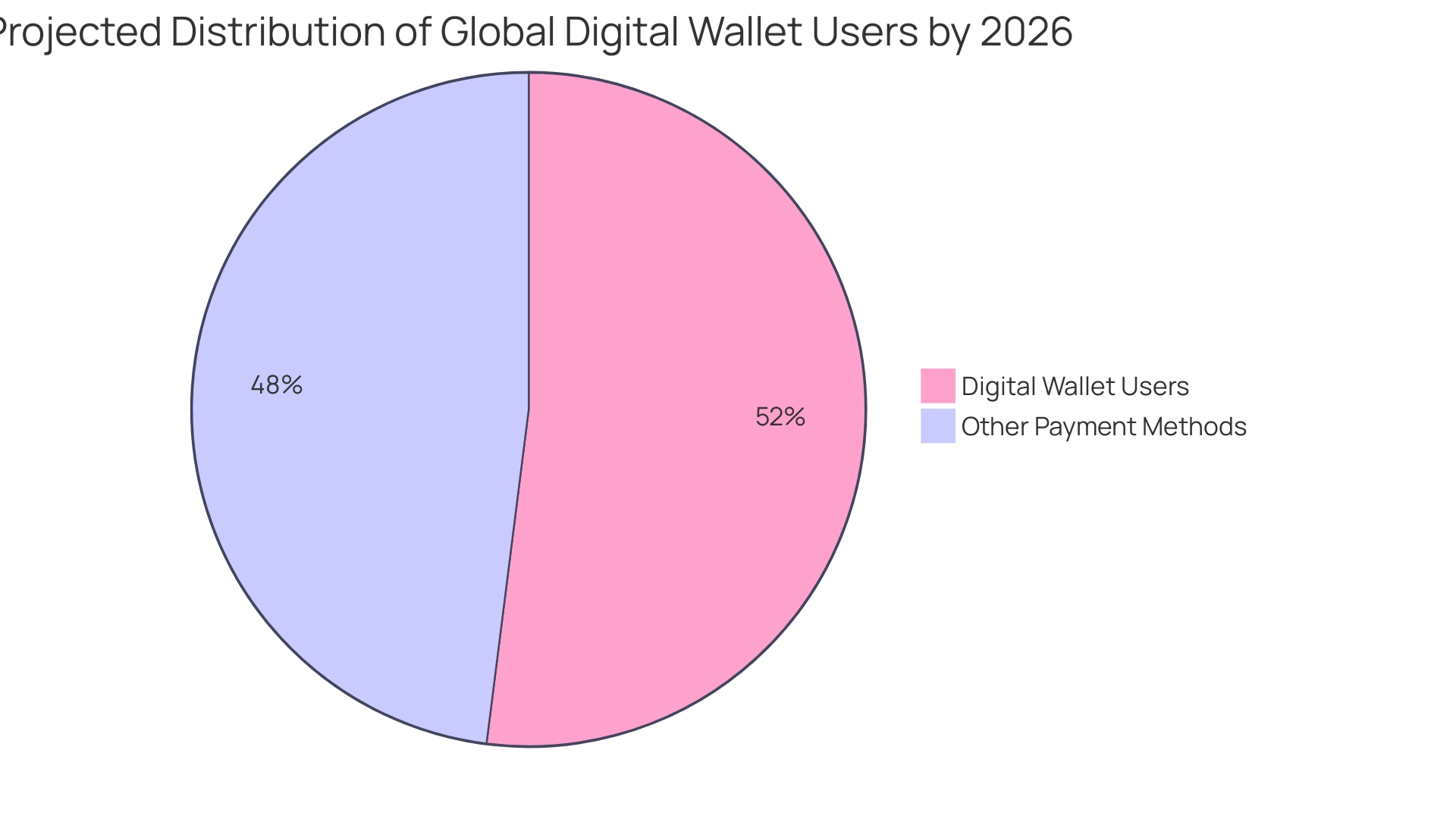
Additional m-commerce categories
Mobile commerce (m-commerce) is not limited to the basic types of transactions. It extends into various categories that utilize technology for improved user experiences and optimized transactions. Key areas include:
-
Mobile Marketing: As mobile devices have become integral to daily life, mobile advertising has grown significantly. This form of marketing, which occurs on smartphones and tablets, is both effective and budget-friendly. A robust online presence is vital for brands aiming to connect with individuals who regularly use their devices.
-
Financial Services for Portable Devices: This category encompasses banking and payment solutions tailored for portable use. With the rise of digital wallets and portable payment options, individuals can conduct financial transactions conveniently and securely while on the move.
-
Digital Catalogs: Retailers are increasingly utilizing digital catalogs to provide customers with easy access to product information and options. This approach not only streamlines the shopping experience but also enhances customer engagement through interactive features.
-
Specialized Applications: Industries such as healthcare and retail are developing dedicated applications to address sector-specific needs. For instance, healthcare applications allow patients to book appointments and retrieve medical records through their devices, enhancing overall service delivery.
The ongoing advancement of portable technology requires companies to create new solutions to satisfy user needs. Based on current trends, application usage is at an all-time high, with users spending over five hours per day on applications in 2023, indicating a shift towards device-centric interactions. Brands that embrace these advancements are likely to see significant growth in customer engagement and satisfaction.
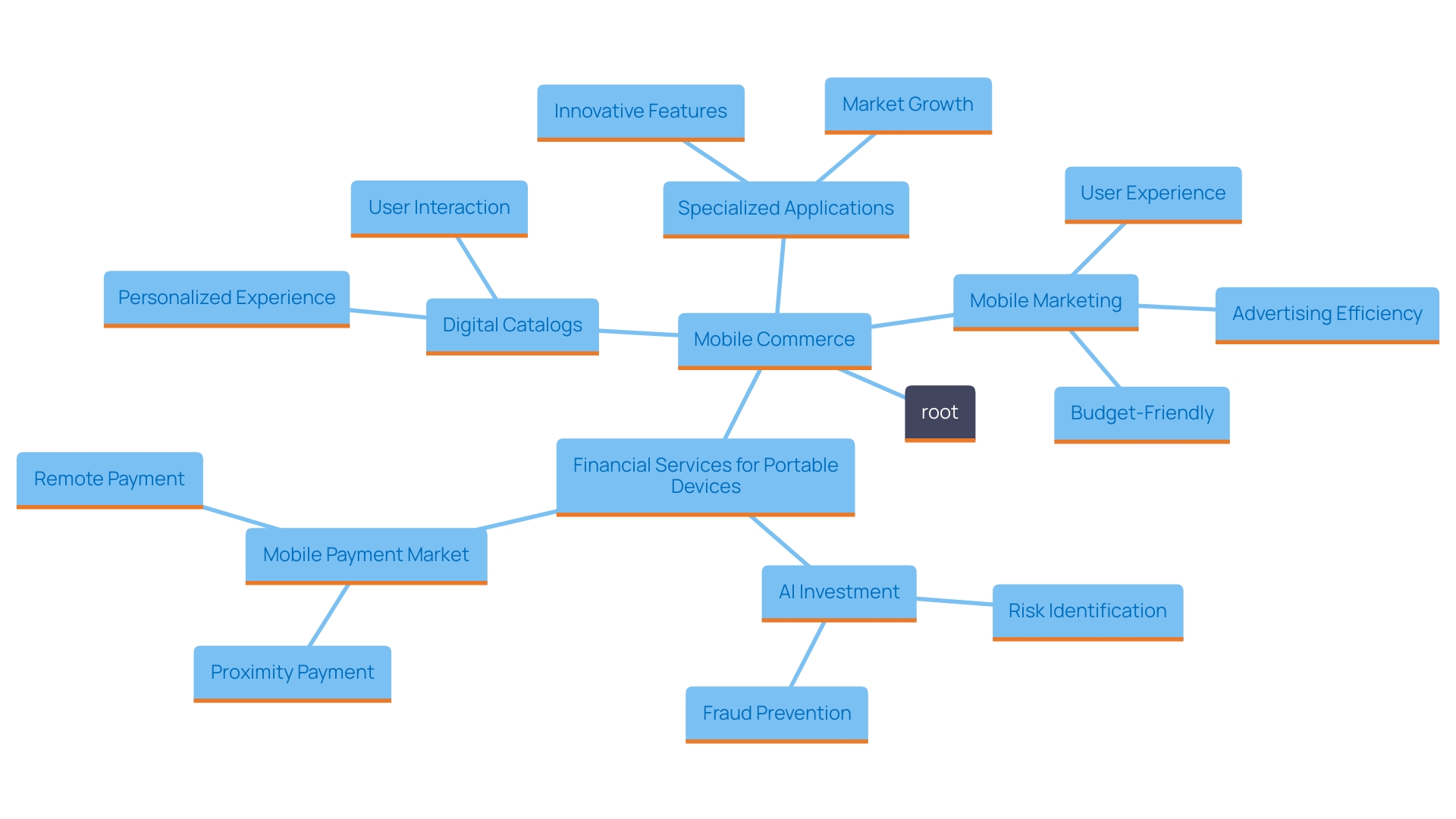
Mobile Commerce for Finance
M-commerce applications in the finance sector are revolutionizing how users interact with their finances. These platforms, such as E*Trade and Fidelity Mobile, offer a wide range of services, including investment management, stock trading, and personal finance tracking. By enabling users to conduct transactions and monitor their investments from their mobile devices, these applications enhance financial literacy and empower users to make informed decisions.
For instance, E*Trade stands out with its user-friendly interface, making trading accessible for both novice and experienced investors. It provides a variety of investment products, including stocks, ETFs, and mutual funds, accompanied by extensive research tools and educational resources. This combination helps users navigate the complexities of investment while ensuring they stay updated with real-time market data and expert insights.
The effectiveness of investing apps is underscored by their ability to create digital records of financial activities. This functionality enables lenders to assess creditworthiness, particularly for individuals without established credit histories. As noted by financial experts, such platforms allow users to track their transactions meticulously, which aids in making informed decisions regarding loans and investments.
Furthermore, the adoption of these m-commerce applications is supported by research indicating a growing trend in digital finance. According to industry benchmarks, the shift towards mobile-first solutions is not merely a fleeting trend; it reflects a fundamental change in user behavior, with individuals increasingly seeking practical, easy-to-use tools that fit seamlessly into their daily lives. As Damien Warren, Senior Vice President at U.S. Bank, emphasizes, individuals prioritize functionality over aesthetics, demanding solutions that address their immediate financial needs.
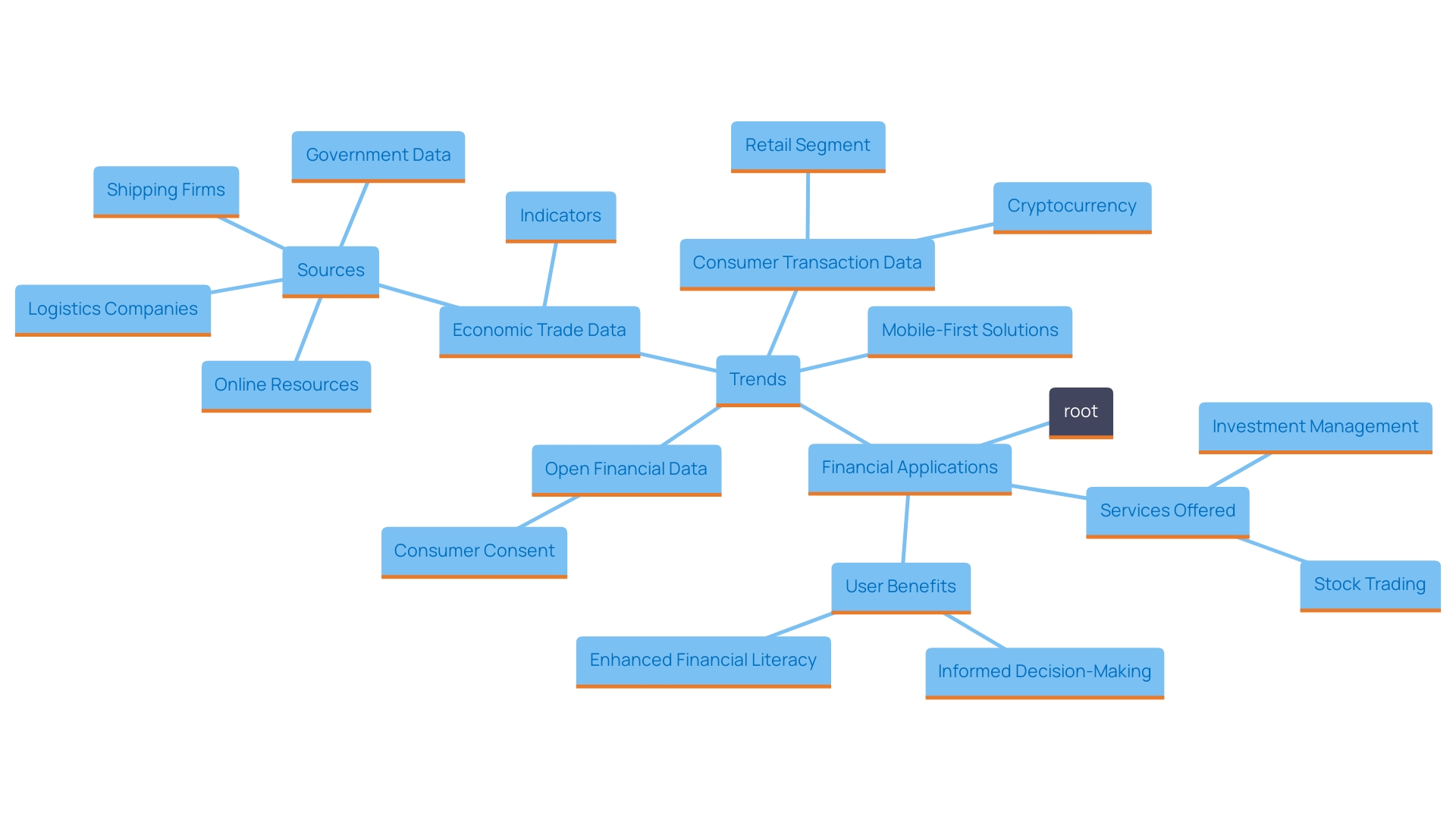
Mobile Commerce for Catalogs
Mobile catalogs are transforming the way consumers interact with products and services, offering a dynamic platform for browsing and purchasing directly from their devices. This evolution is especially beneficial for companies with wide product ranges, as it simplifies the purchasing process and boosts customer interaction.
With digital catalogs, customers can access a wide array of products at their fingertips, enabling them to explore options effortlessly. This is critical in today’s retail landscape, where approximately 72% of fashion and sportswear shoppers prefer a hybrid shopping approach, utilizing both online and in-store experiences. Such catalogs not only facilitate immediate purchases but also allow users to compare products and make informed decisions, addressing the tactile needs that 55% of shoppers prioritize when choosing items.
Furthermore, the incorporation of advanced technologies in portable catalogs can lead to higher conversion rates. For instance, a recent report indicated significant benchmarks related to customer activation across different industries, suggesting that optimized interfaces can drastically improve user engagement and sales performance. As businesses more and more acknowledge the potential of commerce through devices, the capability to display products online becomes a crucial element of a thorough e-commerce strategy.
In a setting where buyers anticipate smooth shifts between online and in-store shopping, introducing efficient mobile catalogs is no longer a choice; it’s a strategic requirement.
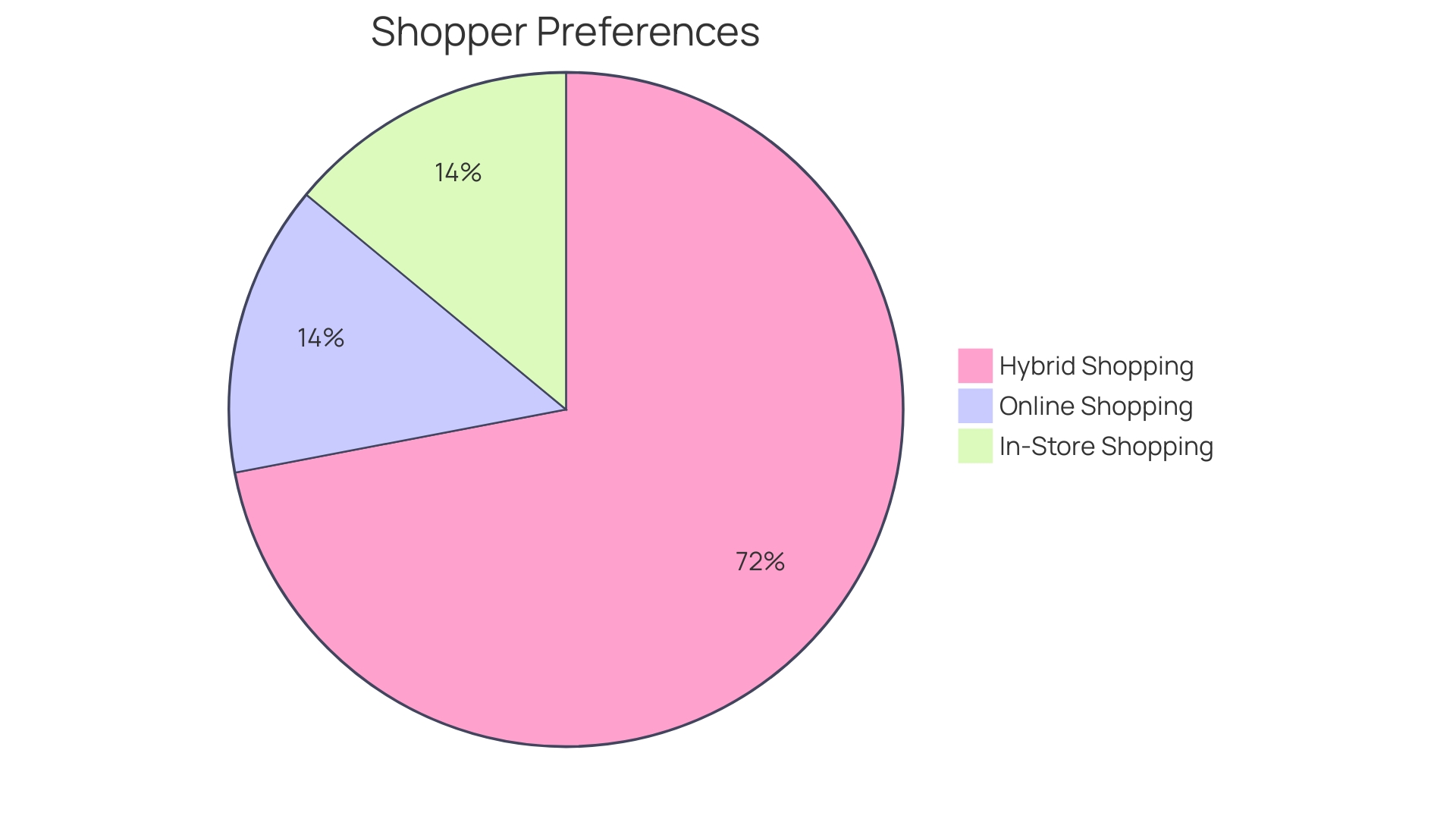
Mobile Commerce for Mobile Marketing
Mobile marketing utilizes m-commerce platforms to create engaging experiences for individuals through a variety of targeted strategies. This encompasses techniques such as push notifications, SMS marketing, and location-based services, all meticulously designed to enhance customer relationships and drive conversions. For instance, Ticketmaster successfully implemented web push notifications to connect with both existing customers and new users. By targeting them based on their previous behaviors, Ticketmaster aimed to boost sales and keep customers informed about upcoming events, thus reinforcing brand loyalty.
Mobile devices have become essential to daily life, fundamentally influencing purchasing behavior. As highlighted in industry insights, many individuals now favor obtaining information and engaging with brands through handheld gadgets. This shift highlights the increasing significance of portable advertising as a cost-efficient way to attract consumer attention. 'With brands continually innovating in ad design, advertising on devices not only helps retain existing customers but also attracts new audiences, ensuring long-term growth and sustainability.'.
Furthermore, the impact of smartphone advertising tactics can be observed in several reports centered on the activation stage of the customer lifecycle. These benchmarks reveal essential insights into how businesses can improve their online presence to enhance user interactions. As Barbara Spiering, VP of Marketing Technologies at Starbucks, emphasized during the Altitude Awards, the creativity and measurable effect of digital strategies can significantly enhance brand performance in a competitive environment.
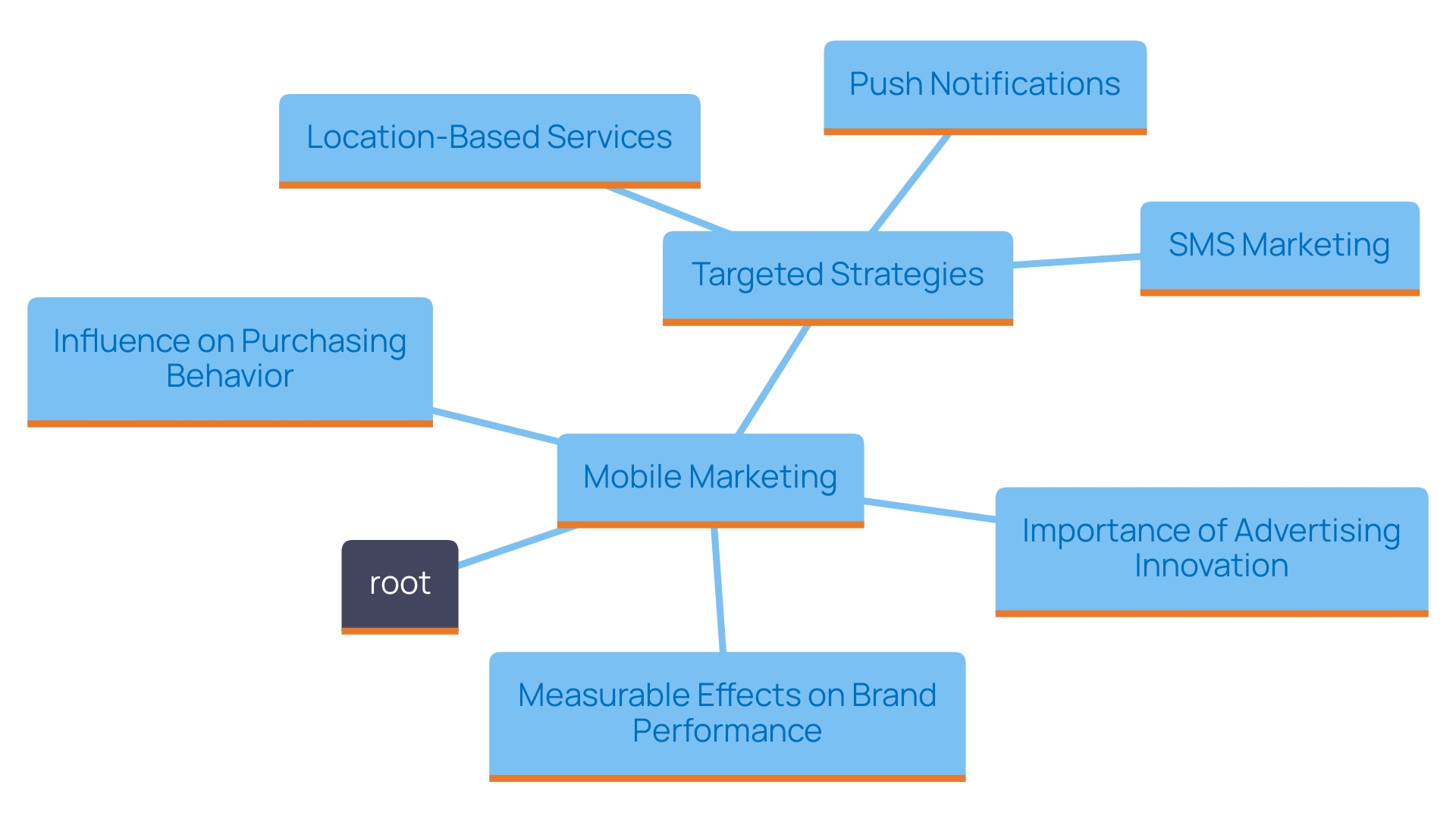
Mobile Commerce for Retail and After-sale Services
Retailers are increasingly incorporating mobile commerce (m-commerce) strategies to improve customer service and after-sale support, creating a more seamless purchasing process. Mobile applications are now at the forefront, providing functionalities such as order tracking, customer feedback, and loyalty programs, which significantly enhance the overall purchasing experience.
Recent studies suggest that contemporary consumers, particularly in the fashion and sportswear industries, no longer identify as solely online or in-store buyers; 72% of them favor a combination of both shopping methods. This shift underscores the necessity for retailers to provide consistent interactions across all channels. For example, 55% of shoppers appreciate the tactile sensation of touching and feeling products, while 35% visit physical stores to compare options. This highlights the importance of m-commerce in bridging the gap between online convenience and in-store engagement.
Moreover, the integration of online and offline platforms is crucial for creating a coherent user ecosystem. Retailers like MediaMarkt are leading the charge, leveraging their extensive digital presence to boost in-store sales. They recognize that while many purchases are initiated online, a significant portion of research and decision-making occurs in physical stores. To adjust to changing buyer behaviors, businesses must ensure seamless experiences across various points of sale.
As the retail landscape continues to evolve, emerging all-in-one platforms are becoming pivotal in streamlining operations. These platforms allow retailers to manage everything from customer relationship management to inventory control in one cohesive interface, ultimately enhancing customer satisfaction. In this rapidly changing environment, the ability to gather and analyze data effectively is essential. It empowers businesses to make informed decisions that align with shifting consumer expectations, thereby securing long-term competitive advantages.
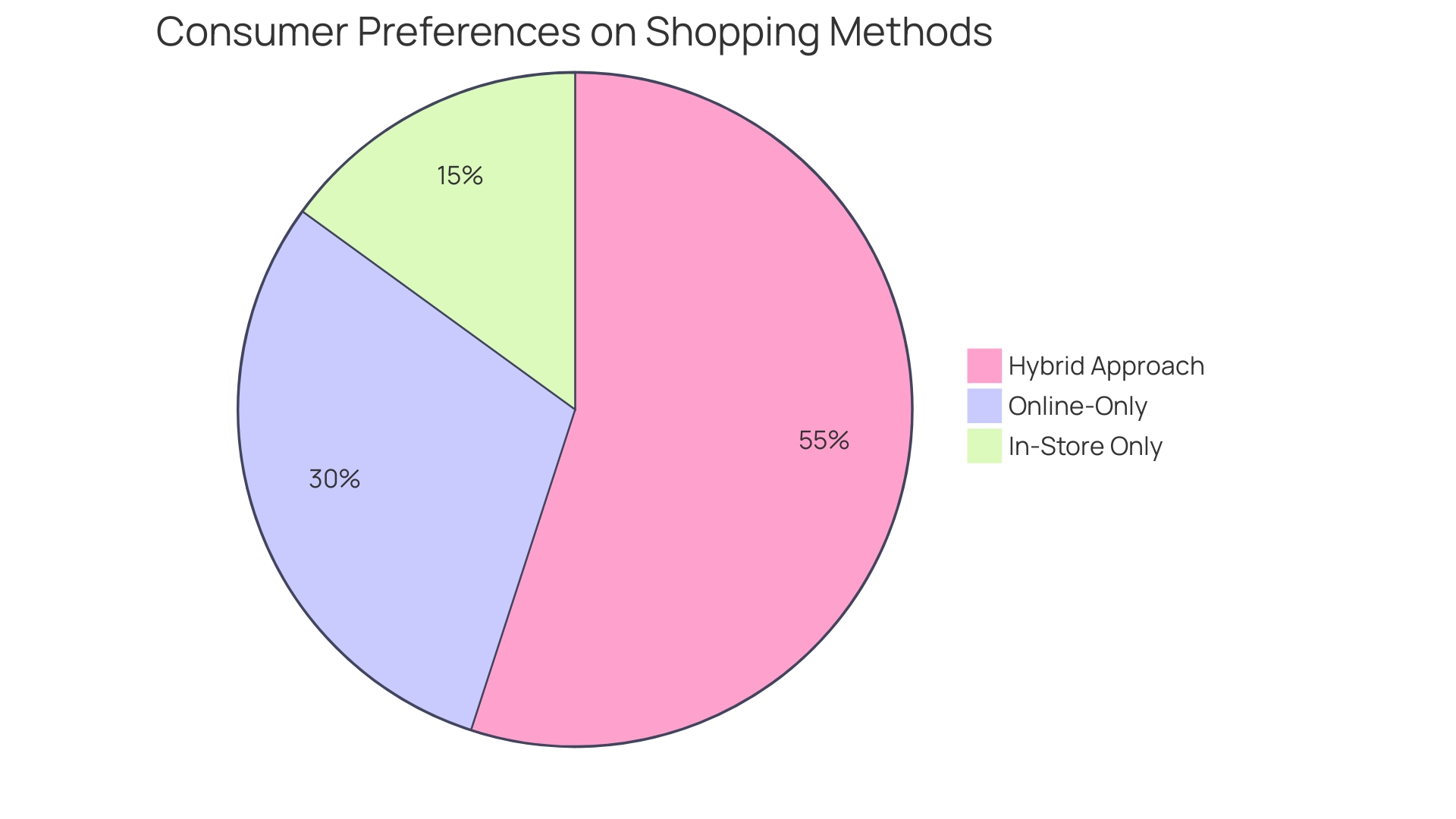
Mobile Commerce for Healthcare and Medicine
In the healthcare sector, commerce applications have transformed the manner in which services are provided, especially through telemedicine, appointment scheduling, and prescription refills. These innovations not only enhance patient access to vital healthcare services but also streamline communication between patients and healthcare providers.
Telemedicine, which has roots dating back over a century, has gained significant traction recently, especially during the COVID-19 pandemic. According to recent statistics, the reliance on telehealth surged as medical professionals and patients sought to minimize infection risks while maximizing healthcare resources. This paradigm shift has led to sustained growth in the telemedicine market as healthcare facilities continue to offer remote services post-pandemic.
'One notable example is the SaludConectaMX initiative, which combines applications for smartphones and the internet to monitor the health trajectories of children undergoing cancer treatment in Mexico.'. 'This collaborative health system not only tracks clinical indicators but also incorporates social determinants and caregiver mental health, demonstrating the potential of m-commerce applications to enhance patient outcomes through comprehensive monitoring.'.
Furthermore, partnerships like that of Netsmart and NorthStar Care Community underscore the importance of technology in improving patient care. As NorthStar’s President and CEO Patrick Miller emphasized, leveraging technology at the bedside can significantly enhance communication with patients and their families, addressing unmet needs in care delivery. These advancements reflect the evolving landscape of healthcare technology, where mobile applications play a crucial role in facilitating timely and effective patient-provider interactions.
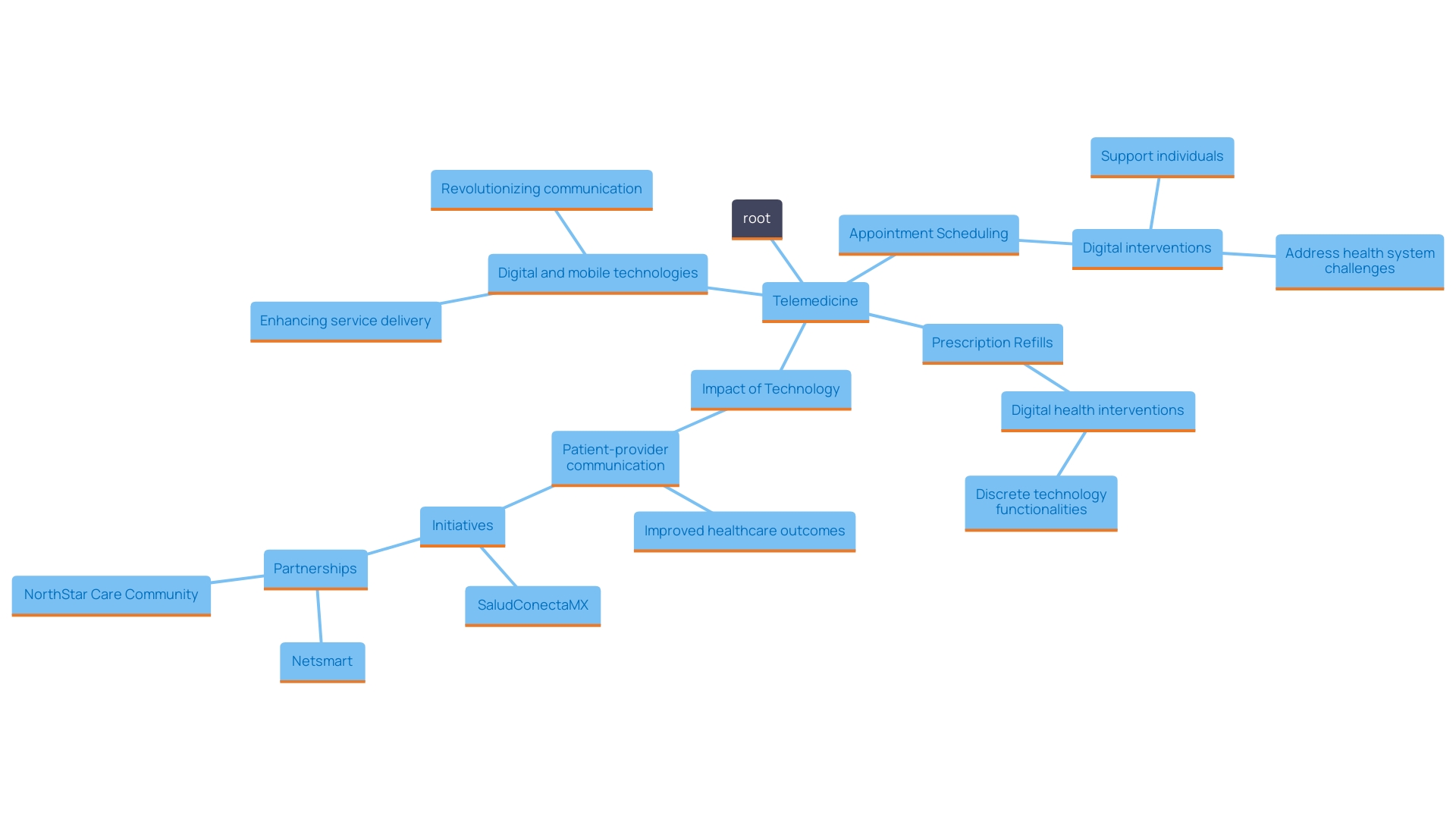
Benefits of m-commerce
Mobile commerce (m-commerce) offers numerous advantages that change the purchasing journey for individuals and companies alike. One of the foremost advantages is the heightened convenience it offers. Shoppers can browse and purchase products anytime and anywhere, which is especially crucial in today's fast-paced world where time is of the essence. This flexibility removes the constraints of conventional buying, allowing consumers to make purchases on-the-go or from the comfort of their homes.
Moreover, m-commerce significantly enhances user engagement. With the integration of advanced features such as personalized recommendations, loyalty programs, and seamless payment options, businesses can foster deeper connections with their customers. For instance, studies reveal that 72% of fashion and sportswear shoppers now identify as both online and in-store customers, highlighting the significance of a consistent and engaging interaction across all channels. This transition highlights the importance for retailers to connect the divide between online and in-store environments, as consumers increasingly anticipate a unified journey.
Furthermore, m-commerce enables businesses to tap into a broader audience. With the number of online shops surpassing physical stores in certain markets, like the Netherlands, companies are presented with unprecedented opportunities to reach potential customers. The capability to promote items via portable platforms not only enhances visibility but also boosts higher conversion rates. In fact, research indicates that 55% of shoppers value the tactile experience of in-store retail, often leading them to make purchases after engaging with products directly. Thus, m-commerce serves as a powerful tool for converting casual browsers into loyal customers.
In summary, the advantages of commerce on handheld devices extend beyond mere convenience, encompassing enhanced user engagement and wider market reach, ultimately contributing to higher conversion rates and a more dynamic shopping landscape.
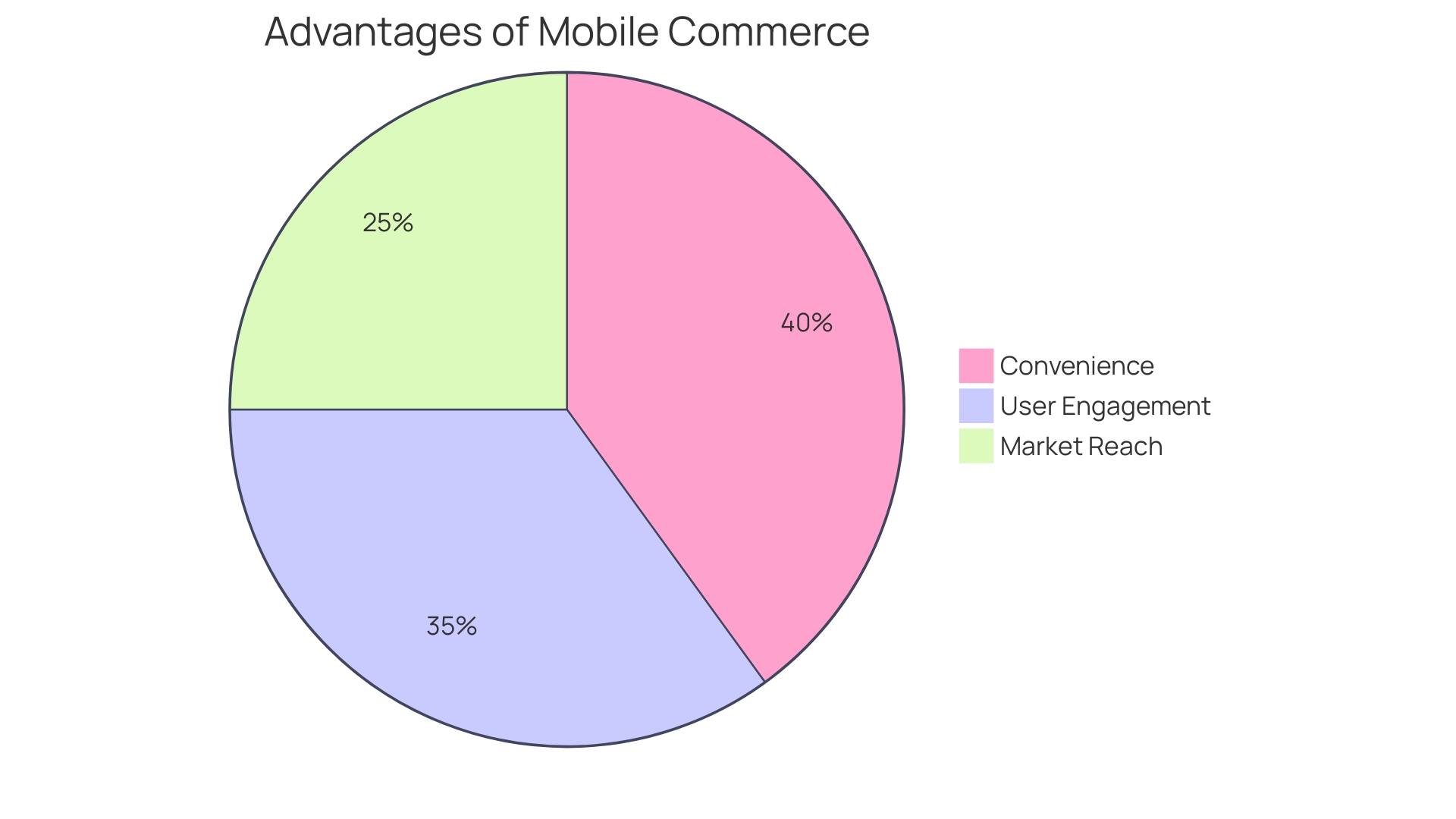
Comparing m-commerce and e-commerce
M-commerce, or commerce conducted via handheld devices, is a specialized subset of e-commerce that focuses specifically on transactions carried out through gadgets such as smartphones and tablets. This distinction is becoming more important in today's digital environment, as the growth of portable technology continues to reshape consumer behavior and expectations.
'Recent studies reveal that a remarkable 59% of online sales on Thanksgiving Day 2022 came from handheld devices, marking an all-time high and a 14% increase year-over-year, according to Adobe Analytics.'. This trend underscores the crucial role that mobile platforms play in driving sales and influencing purchase decisions. Moreover, the evolving user interaction (UX) has become central to retaining customer engagement across various touchpoints—from initial ad clicks to product reviews. As e-commerce expands, retailers are sitting on a goldmine of data that can be leveraged to understand consumer personas and optimize marketing strategies.
Furthermore, the increasing combination of mobile transactions with in-store activities indicates a change in consumer behaviors. According to research by Outform, 72% of shoppers now prefer to combine online and in-store interactions, seeking a seamless transition between the two. Notably, 55% value the tactile experience of physically engaging with products before making a purchase, while 69% draw inspiration from in-store shopping.
In terms of market segments, e-commerce includes a variety of industries, such as retail, goods for buyers, travel, and hospitality, and is expected to maintain its swift expansion. The ability to reach a global customer base while offering innovative products and services is a key advantage of this expansive market. As portable commerce continues to develop, it offers both challenges and opportunities for retailers to address the varied needs of buyers in an ever more competitive landscape.
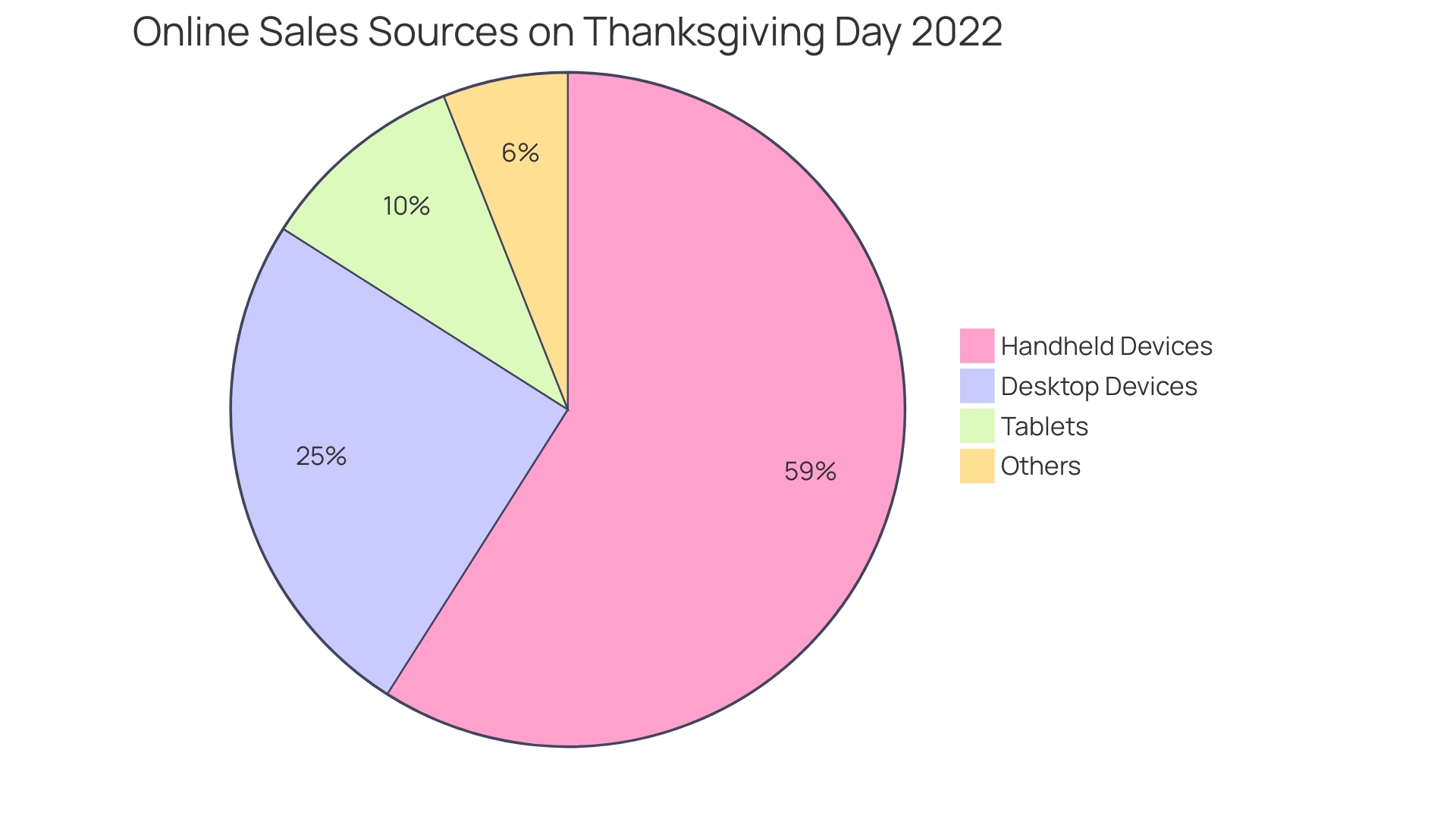
Key m-commerce areas
In the changing environment of commerce on portable devices (m-commerce), several critical areas require focus to guarantee success and competitiveness. Enhancing user interaction (UX) is essential; studies show that more than 50% of customers will avoid brands with inadequately designed smartphone platforms. Users increasingly prefer functionality over aesthetics, favoring a simple, responsive design that facilitates a smooth shopping experience. In fact, websites that load within two seconds can achieve a conversion rate that is 15% higher than average, highlighting the necessity for speed and efficiency in user interactions.
Security measures for transactions are equally vital in gaining consumer trust. As portable payments continue to gain traction—valued at $53.5 billion in 2022 and projected to exceed $607.9 billion by 2030—ensuring robust security protocols can significantly impact customer confidence. Applying advanced encryption and secure payment gateways can reduce potential risks related to transactions on smartphones.
Additionally, the integration of advanced technologies like artificial intelligence (AI) and augmented reality (AR) is reshaping the m-commerce landscape. For instance, AI can help tailor user interactions by analyzing shopping behavior, while AR can provide immersive shopping encounters, enhancing product visualization. Spotify's evolution in the podcast space exemplifies this trend, as they leverage cutting-edge technology to engage users in innovative ways, reinforcing the importance of staying ahead of the curve in technology adoption.
Collectively, these focus areas—user experience, security, and technological integration—are not merely trends; they are essential components for thriving in the competitive marketplace.
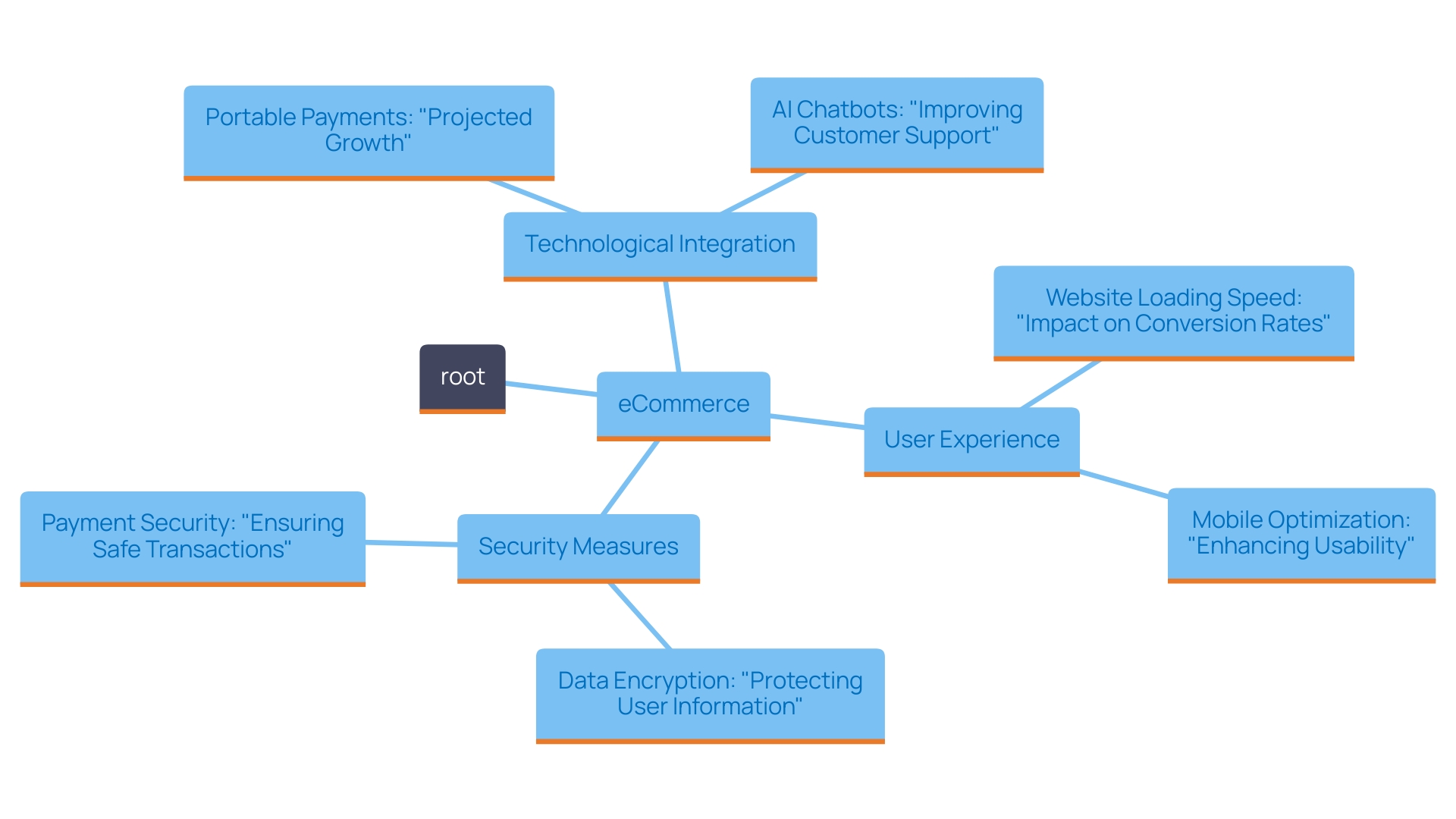
Future trends in m-commerce
The landscape of mobile commerce (m-commerce) is rapidly transforming, driven by several dynamic trends that are reshaping buyer behavior and expectations. One of the most notable shifts is the rise of voice-activated purchasing. This technology enables individuals to make purchases without using their hands and streamlines the buying process, addressing the growing need for convenience and speed in the retail environment.
Additionally, augmented reality (AR) is becoming a crucial tool for product visualization, enabling customers to interact with products in a virtual space before making a purchase. This captivating interaction not only boosts user involvement but also greatly diminishes the unpredictability frequently linked to online purchasing. 'Based on reports, the incorporation of AR in retail interactions has been demonstrated to boost conversion rates, as shoppers feel more assured in their buying choices.'.
Artificial intelligence (AI) is further enhancing personalization in m-commerce, allowing retailers to tailor their offerings to individual preferences. As Suresh Kumar, Global Chief Technology Officer at Walmart Inc., points out, comprehending the deeper context behind purchases is crucial for crafting deeply personal retail encounters. This level of customization is no longer a luxury but a necessity, as buyers increasingly expect brands to intuitively meet their needs across multiple channels.
As we look towards the future, the market for m-commerce is poised for tremendous growth, with projections indicating that global gaming, a sector increasingly intertwined with retail, is expected to reach a staggering $1,065 billion by 2032. This evolution indicates that m-commerce will not only serve traditional retail but will broaden into new avenues where individuals seek effortless purchasing experiences.
In summary, the future of m-commerce is bright, characterized by innovative technologies such as voice purchasing, AR, and AI. These advancements promise to enrich the consumer journey, making shopping more accessible, personalized, and engaging.
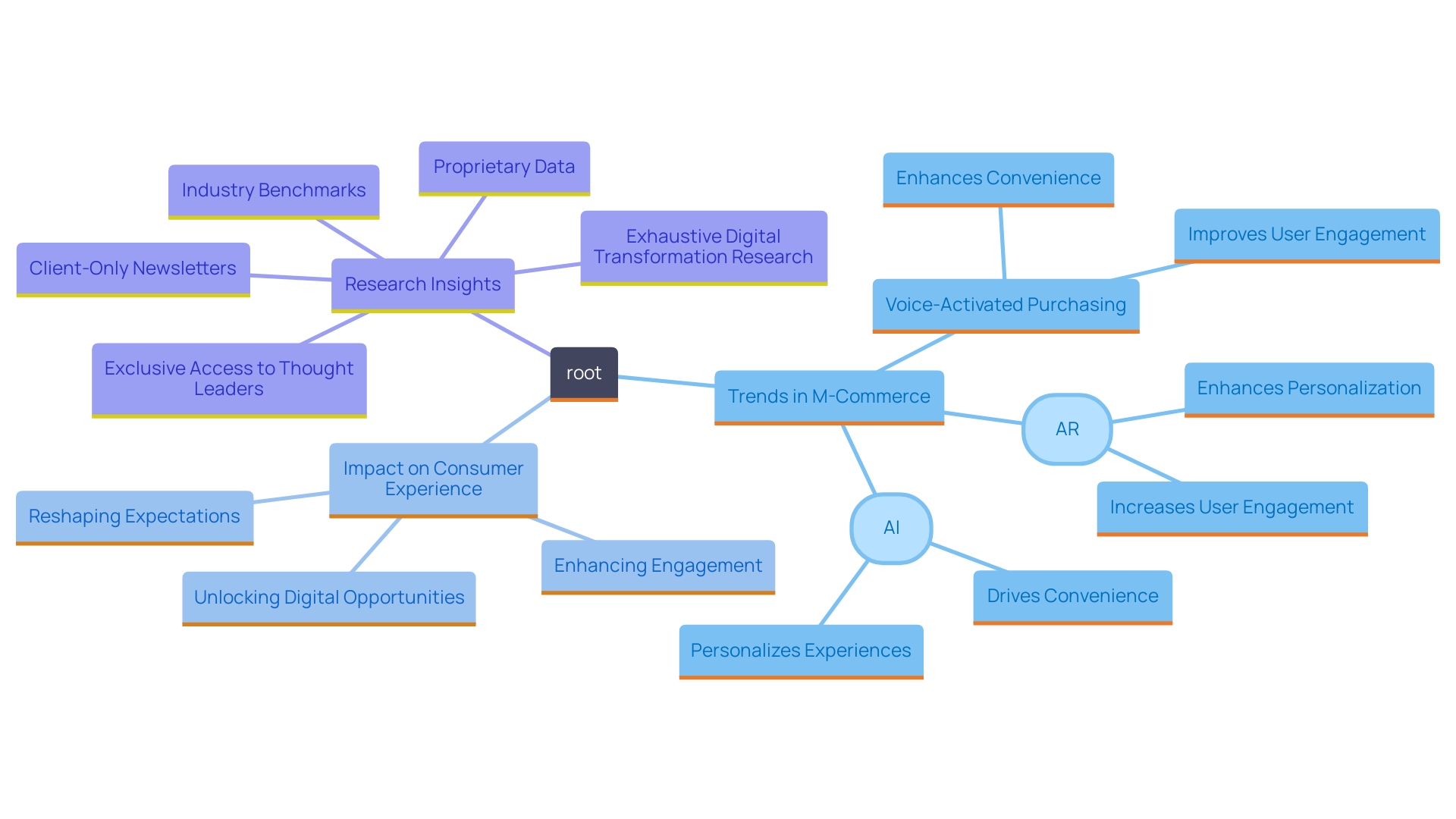
Conclusion
The emergence of mobile commerce (m-commerce) is not just a fleeting trend; it represents a fundamental shift in how consumers engage with products and services. This article has explored the expansive landscape of m-commerce, highlighting its various facets, including mobile shopping, banking, payments, and marketing. Each segment plays a critical role in shaping consumer behavior, emphasizing the necessity for businesses to adapt their strategies to remain competitive.
The benefits of m-commerce are manifold. Enhanced convenience, user engagement, and broader market reach are pivotal advantages that businesses can leverage to attract and retain customers. The integration of advanced technologies such as AI and AR further enriches the shopping experience, allowing for personalized interactions that meet the evolving demands of a tech-savvy audience.
As the m-commerce landscape continues to evolve, it is essential for businesses to prioritize user experience, security, and technological innovation. By doing so, they can not only stay ahead of the competition but also foster deeper connections with their customers. The future of m-commerce is poised for explosive growth, driven by emerging trends that promise to redefine the retail experience.
Adapting to these changes is crucial for businesses aiming to thrive in this dynamic digital economy.





